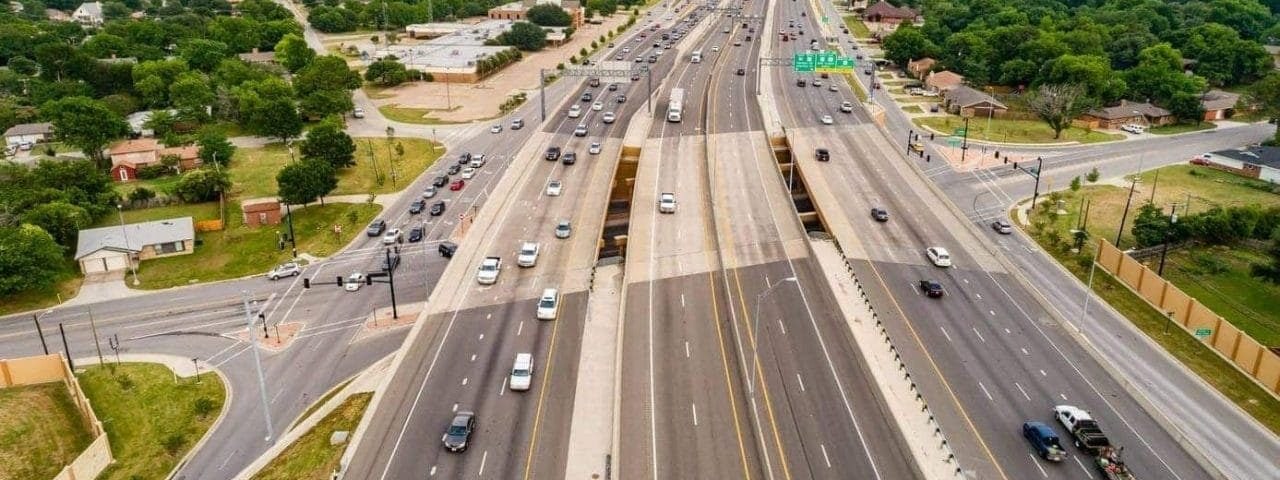
The Dallas-Fort Worth (DFW) metroplex area is currently home to over 7.5 million people according to the US Census Bureau’s 2020 census and is ranked as the fastest growing city in Texas. For perspective, the population increased by 24% between 2010 and 2020 and is only expected to continue growing. DFW might be the place to be right now, but what does this mean for its infrastructure and how can we keep people moving about quickly and safely. These questions have been driving our work over here at Cintra and one of the major answers has been the North Tarrant Express highway (NTE).
Innovation is Key
The NTE first broke ground in 2009 as a collaborative effort between Cintra and the Texas Department of Transportation (TxDOT) and since then has proved to be a great success in alleviating congestion and improving mobility for over 13 million vehicles to date. One of the most innovative aspects of the NTE is the incorporation of (MLs), called TEXpress Lanes, as a way to keep traffic moving above 50mph irrespective of the time of day and traffic conditions.
Real Solutions in Real Time
As a transportation engineer, my job is to get people from point A to point B as quickly and safely as possible. I’m passionate about finding real-time solutions to do so. Prior to working for Cintra, I was working as a transportation consultant for different departments of transportation around the US. We were working on interesting projects that would improve traffic in the coming years, but I wanted to see if there was a way to improve traffic now.
Traffic can make or break someone’s day because of its unpredictable nature, so what if there was a way to limit the unpredictability and make traffic a thing of the past? Well, this is where the TEXpress Lanes come in and why I find my job so interesting! By using traffic analysis and responding with the appropriate pricing strategy, we help keep traffic flowing so you won’t be sitting in bumper-to-bumper traffic on your daily commutes.
In order to adjust toll prices accordingly to keep congestion down and traffic moving, we have a smart system and algorithm in place to do the work. This guarantees a constant monitorization of the toll road, with human interaction only necessary from time to time to ensure there that the system is running smoothly.
Money Matters
Now what about the affordability of a service like this? It’s certainly true that this type of service comes at a cost, but our goal is to strike the right balance between the quality of service and the price. At peak times, you typically won’t see a toll higher than $.93/mile on TEXpress lanes, however, if traffic is building up, to alleviate the traffic congestion and keep people moving. We’re proud to say that we’ve been able to deliver on this promise. Our drivers using the TEXpress lanes have been able to maintain a speed over 71mph on average compared to just 51mphon general-purpose lanes while still being able to keep monthly expenditures down to less than $20 for most drivers (80%).
In addition to the positive impact the TEXpress lanes have on drivers, the revenue that is generated from these tolls has boosted the local economy and allowed us to continue improving and building upon the existing infrastructure to keep North Texans moving. Over the last 11 years, the NTE has generated over $7.5 Billion in cumulative economic impact with the addition of new money flowing into the economy. The project directly created 4,300 jobs annually during construction and an additional 3,200 indirect jobs annually within the DFW Metroplex. .
In addition, the project has improved connectivity in the area. Future expansions on the managed lanes (MLs) and general-purpose lanes are also being planned to allow motorists to have more additional lanes to choose from, giving them more choice in how to travel depending on their objectives.
Reshaping Mobility for the Future
As a consumer, choice is something they are constantly striving for. It’s simple economics- the more choices we have for a product or service, the better the product or service. This concept is present in many aspects of our consumerist lives from grocery shopping to home buying, for instance, but hasn’t been utilized in the same way when we talk about roadways. Sure, toll roads and freeways have been the two main choices for motorists for decades, but what if we can provide choices for drivers on already existing highways? Now motorists won’t have to change their route as they would have to by taking a separately tolled highway. Instead, they could take their same route, but choose the speed in which they’d like to travel.
This is the concept of managed lanes that is reshaping mobility. With the speed at which our cities are growing, especially here in Texas, we have to be thinking about how to make our roads better for drivers and one of the ways is to give driver’s more options. The success of the TEXpress lanes on the NTE has given us a positive outlook for the future of mobility not only here in Texas, but worldwide.





There are no comments yet